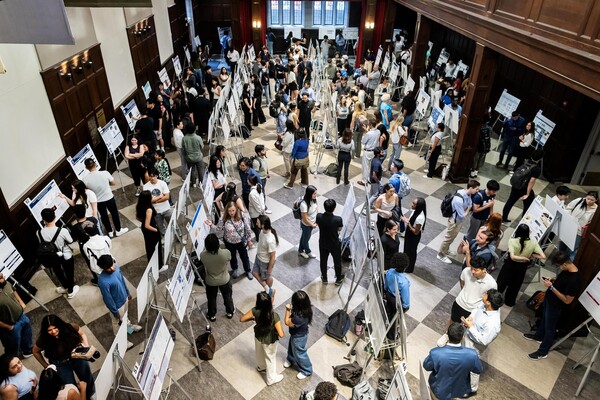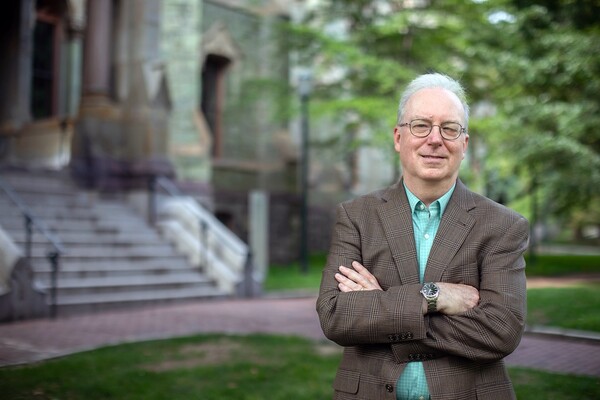
Image: Mininyx Doodle via Getty Images
For decades, Middle East expert Ian Lustick was a firm believer in the two-state solution as a path to peace in Israel.
Yet, after watching diplomats and politicians fail again and again to negotiate a path toward separate Israeli and Palestinian states, he says he needed to rethink the problem.
His new book, “Paradigm Lost: From Two-State Solution to One-State Reality,” makes the case for a new way of looking at the issue.
“The idea of two-states for two peoples is a pretty picture of the future, but without any plausible way to get there, it can no longer properly be called a solution,” he says. “It is just one, but only one, pretty picture of an unattainable future.”
Lustick, a professor of political science and the Bess W. Heyman Chair in the Political Science Department in the School of Arts and Sciences, spoke to Penn Today about why he thinks the two-state solution is doomed, and what that means for the region between the Jordan River and the Mediterranean Sea.
The most obvious reason, but not the most important, is that nearly 10% of all Israeli Jews now live in the West Bank, including expanded East Jerusalem. But settlements are important as a barrier to a two-state solution only because of how completely the Israeli political system has been transformed. It has shifted very far to the right. In American terms, Israel used to be blue—think Maryland or Rhode Island—then it became purple—think Pennsylvania or Ohio; but now it is deep red—Oklahoma or Idaho. For years now, in fact, even those few in Israel who do support a genuine two-state solution have been unable to explain how it could actually be achieved.
While the slogan of a ‘one-state solution’ has held out the equally impossible idea of negotiations between Jews and Palestinians to form a single democratic binational state, the idea of a ‘one-state reality’ focuses on the simple, bare fact that there is one and only one state operating between the Mediterranean Sea and the Jordan River. That reality—of Israel as a state determining the life chances of six million Arabs living under its sway, most of whom have no political rights within it; six million Jews; and hundreds of thousands of non-Jewish non-Arabs—does not present a pretty picture. It is not a solution, but it is a fact—a fact with political dynamics of its own that in the long run will lead to major transformations that, relying on the experience of other states ruling large and previously excluded groups, will include bitter struggles but also democratization.
At bottom, the one-state reality means three things. First, successful negotiations for a two-state solution are no longer possible; second, the real challenge is to find ways, over decades or generations, to transform that one state that does exist; and third, doomed efforts to achieve a negotiated two-state solution only deepen the oppression that is built-in to the one-state reality and postpones the kinds of mobilizations and struggles necessary to change it.
In the book, through each chapter, I show how the unintended consequences of projects to do one thing ended up with something else and together they prevented the two-state solution. The book ends on the dynamics of the one-state reality, comparing it to cases you wouldn’t normally consider, like the United States after the Civil War, the annexation of Ireland in the 1800s, and South Africa’s apartheid system.
Lincoln fought the Civil War on behalf of a ‘one-state solution,’ but he never advocated for a multiracial democracy. Almost nobody wanted that, but what we ended up with was the unintended consequences of a campaign to get something else. The consequence of the Union winning the war was eventually a long road to a multiracial democracy.
In Ireland, the annexation of Ireland in 1800 produced 80 years of struggle to enfranchise the Irish Catholics. Once they had the vote, they transformed British politics, and it resulted eventually in a two-state solution, to secession. That could happen in 100 years in Israel, too.
In South Africa, did the whites who set up the apartheid system do so because they figured after years of struggle there would be a multiracial democracy? No. But that was the unintended consequence.
In the first chapters I focus on three: the unanticipated consequences of what I call the ‘flaw in the Iron Wall’; the pervasive effects of the ascendance of a way to think about the Holocaust that was politically extremizing; and the impact on Israeli politics of the operation in the United States of a powerful Israel lobby.
Take the example of the Iron Wall. When Zionists came to Palestine, they knew pretty fast that there was nothing they had to offer the Arabs, that if they had been the Arabs they would have accepted.
So, what was done? They erected what was called an ‘Iron Wall,’ knowing the Arabs would continually attack them, but they defeated them in war after war until the Arabs split. The idea was they would isolate the extremists and make a deal with the moderates.
The architects of this strategy forgot one thing. If the consequences of a people losing and losing and losing is that eventually they give up some of their demands, what’s the unintended consequence of a people winning and winning and winning? Are they likely to become more willing to compromise? No, instead they go the other direction and expand and adopt maximalist positions. That is what happened in Israeli politics, and that prevented successful negotiations with Palestinian Arabs.
Thus, I show how the unintended consequence of the success of the first stages of this strategy was the failure of the latter stages.
When you put mass populations together that are suspect and have been hated in the past and excluded and discriminated against, it takes a long time, but eventually groups inside each of those populations find reason to ally with some groups across the dividing line between the populations.
How do people break with ideas that are so deep in them that they can’t think beyond them? Beliefs so fundamental they are resistant to evidence is something I teach about all the time called ‘hegemony.’ How do you change a belief that you’ve always assumed was true? It takes a paradigm shift.
Think about the civil rights struggle; think about Jim Crow. How long has it taken to move as far as the U.S. has moved toward a multiracial democracy? Much more than a century. Think about the long and difficult struggles involved. Does Israel have that long? Well, neither the world nor history is fair. They offer no guarantees. Israel might not have that long. But that’s the way politics works.
So, I suggest people who care about the Israeli-Palestinian conflict focus on principles, not on specific outcomes and not on ‘solutions’ but on moving toward better problems. If there’s an option to expand voting rights for East Jerusalem Arabs, do it. Don’t refrain from increasing political equality for fear of ‘legitimizing the occupation’ or interfering with a division of Jerusalem that could support a two-state solution. To do so is to be played for a sucker by those who wish to preserve domination over Palestinian Arabs without any progress toward equality or nondiscrimination. Take a long-term view. In the political system that exists, moderate Jews and moderate Arabs need one another and need one another’s votes. Now that Israel can no longer withdraw from the West Bank and is locked in a permanent if painful and often violent embrace with the two million Arabs in Gaza, Israeli doves who still make the ‘demographic argument’ and try to frighten Israelis with the unacceptability of living with large Palestinian populations simply inflame relations between Jews and Arabs and postpone the time when the necessary alliances between them can be forged.
So that’s one of my main conclusions, once the one-state reality is accepted; a gestalt shift takes place, and many other things change in one’s thinking—about demography, about settlements, about Jerusalem, about U.S. foreign policy, and, ultimately, about Israel as a ‘Jewish,’ as opposed to a truly democratic, state.
Kristen de Groot

Image: Mininyx Doodle via Getty Images

nocred

Image: Pencho Chukov via Getty Images

Charles Kane, Christopher H. Browne Distinguished Professor of Physics at Penn’s School of Arts & Sciences.
(Image: Brooke Sietinsons)